NGC457, The Owl Cluster
Click image for full size version
December 27, 2014; Astronomy Magazine Picture of the Day Oct. 16, 2015
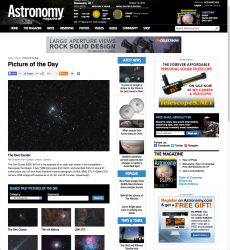 NGC457 is known as the Owl Cluster (also the E.T. Cluster, after the movie E.T.). It is a fine example of an open cluster, a cluster of gravitationally-associated stars inside our galaxy. I don’t often shoot these objects, because they tend to look better through an eyepiece than they do in pictures. However, they make good imaging targets in mediocre conditions. Other examples include the Double Cluster, and M37. Whereas globular clusters have hundreds of thousands of stars, open clusters have dozens to hundreds of stars. Open clusters are easier to resolve into individual stars than globulars, because they are closer and the stars are less densely packed. This shot shows off the variety of colours that stars can have from quite red, to yellow, creamy, white and blue. Colour is a function of temperature (redder is cooler; bluer is hotter — exactly the opposite of how we usually think of red as hot and blue as cold. I have also imaged NGC457 and neighbouring NGC436 in a wider field.
NGC457 is known as the Owl Cluster (also the E.T. Cluster, after the movie E.T.). It is a fine example of an open cluster, a cluster of gravitationally-associated stars inside our galaxy. I don’t often shoot these objects, because they tend to look better through an eyepiece than they do in pictures. However, they make good imaging targets in mediocre conditions. Other examples include the Double Cluster, and M37. Whereas globular clusters have hundreds of thousands of stars, open clusters have dozens to hundreds of stars. Open clusters are easier to resolve into individual stars than globulars, because they are closer and the stars are less densely packed. This shot shows off the variety of colours that stars can have from quite red, to yellow, creamy, white and blue. Colour is a function of temperature (redder is cooler; bluer is hotter — exactly the opposite of how we usually think of red as hot and blue as cold. I have also imaged NGC457 and neighbouring NGC436 in a wider field.
NGC457 is thought to be about 21 million years old, and about 7,900 light years from Earth. It contains about 150 stars. To gauge brightness, the brightest star in the field is visible to the naked eye most nights from my home. The one next to it is never visible from my home with the naked eye. Most of the cluster stars are visible in my 6″-reflector. All of the cluster stars are visible in my 20″-reflector. In fact, the image shows a view similar to what I see in the 20″, but the image shows more colour in the stars.
There are at least a dozen dim galaxies in the field, all 17th magnitude or fainter. They are tough to spot; look for little smudges or fuzzy “stars.” The brightest is halfway from the brightest star to the left edge, slightly higher in the image than the brightest star.
Tekkies:
SBIG STL-11000M camera, Baader RGB filters, 10″ f/6.8 ASA astrograph, Paramount MX. Guided with STL-11000’s external guider and 80 mm f/6 Stellar-Vue refractor. Acquistion and guiding done using Maxim-DL. Focusing with FocusMax. Calibration, registration, integration and all processing in PixInsight. Shot from my SkyShed in Guelph, Ontario. Crescent moon and average to poor transparency and seeing.
9x5m R, 6x5m G and 8x5m B unbinned frames (total=1hr55m).
RGB:
R, G and B masters were cropped and combined to make an RGB image which was processed with DBE and ColourCalibration. HistogramTransformation was applied, followed by TGVDenoise and another HistogramTransformation to reset the black point. SCNR was applied to the background.
Synthetic Luminance:
Creation and cleanup: The cropped R,G and B masters were combined using the ImageIntegration tool (average, additive with scaling, noise evaluation, iterative K-sigma / biweight midvariance, no pixel rejection). DBE was applied to neutralize the background.
Stretching: HistogramTransformation was applied, followed by TGV Denoise and another HistogramTransformation to reset the black point. No pixels were clipped during either stretch.
Combining SynthL with RGB:
The luminance channel of the RGB was extracted, processed and then added back into the RGB image as follows:
1. Extract luminance from the RGB image.
2. Apply LinearFit using the SynthL channel as a reference.
3. Use ChannelCombination in the Lab mode to replace the luminance of the RGB with the fitted luminance from step 2.
4. LRGBCombine was then used to make a SynthLRGB image.
Final Processing
LinearMultiscaleTransform was applied to a copy of the image to sharpen the first 5 wavelet layers (no residual). This image was renamed SS (small scale). PixelMath was used to subtract SS from the SynthLRGB with no rescaling. The resulting image was renamed LS (large scale). Colour saturation was decreased on LS and increased on SS (goal was to increase star core colour and decrease all other colour). Contrast was adjusted in LS to darken the background. PixelMath was used to add SS and LS (no rescaling). Convolution was applied to slightly soften the star cores.
Image scale is about 1.1 arcsec per pixel for this camera / telescope combination.

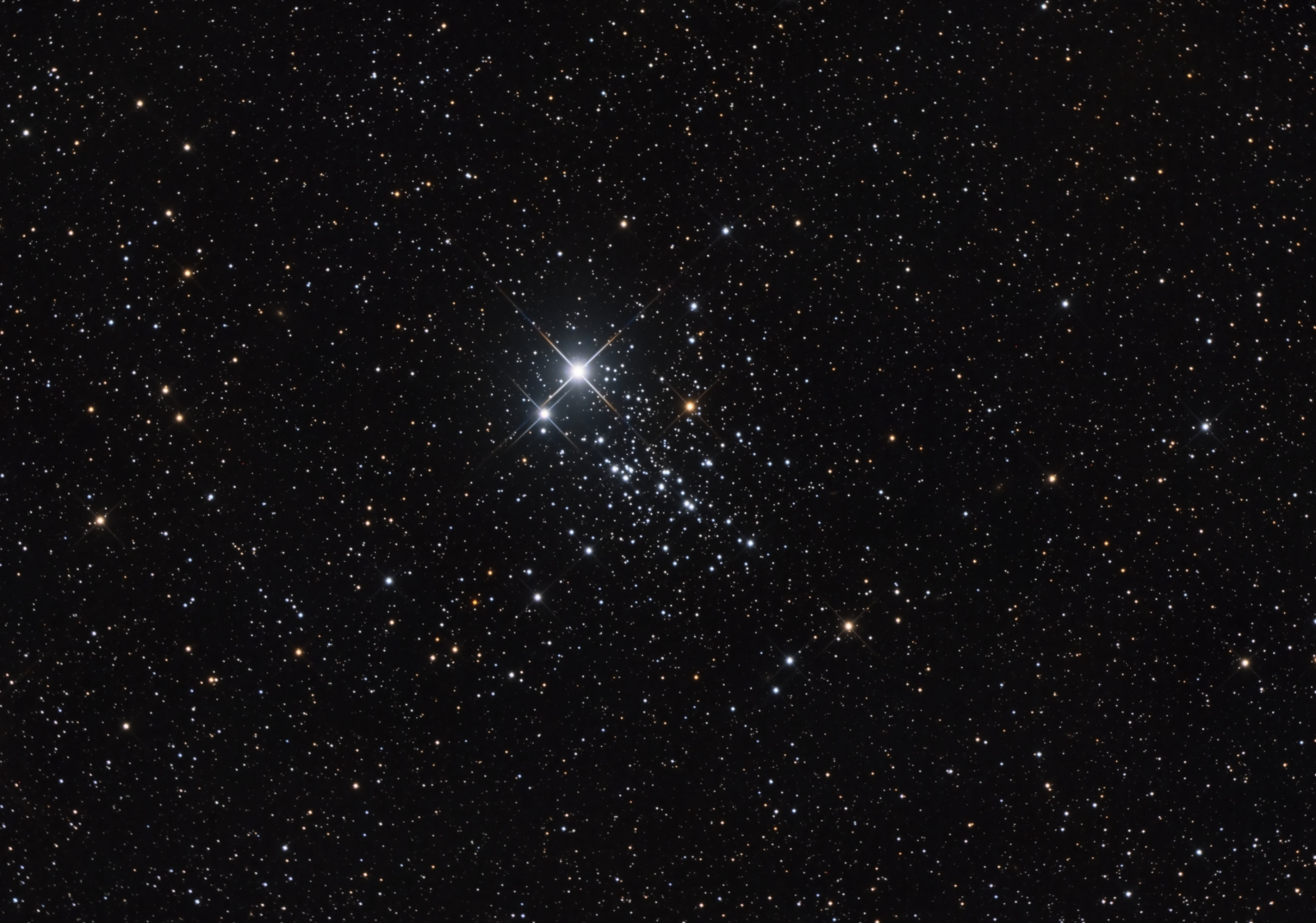
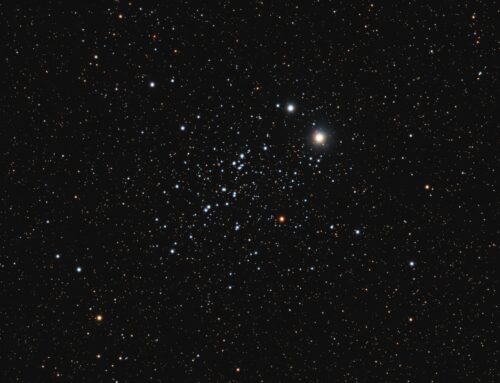
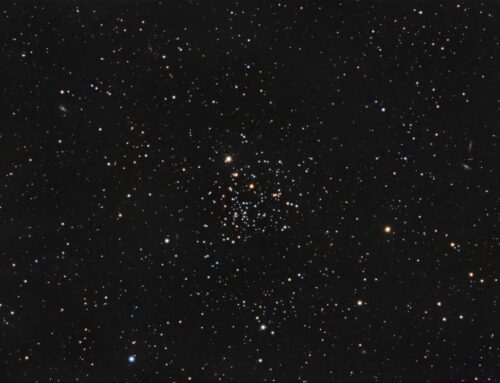

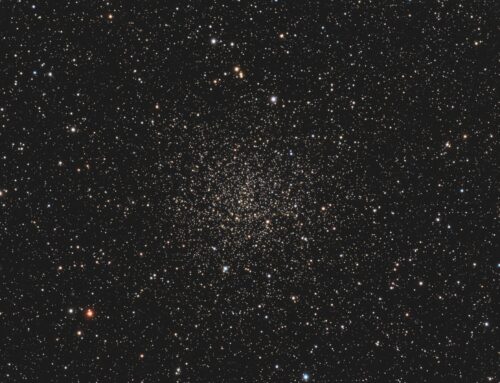
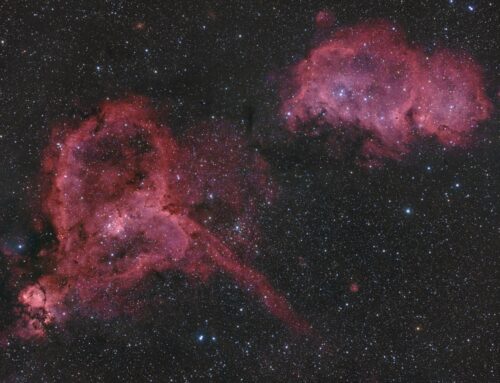
Leave A Comment